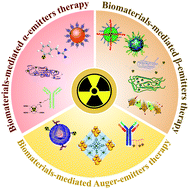Biomaterial-mediated internal radioisotope therapy
Abstract
Radiation therapy (RT), including external beam radiotherapy (EBRT) and internal radioisotope therapy (RIT), has been an indispensable strategy for cancer therapy in clinical practice in recent years. Ionized atoms and free radicals emitted from the nucleus of radioisotopes can cleave a single strand of DNA, inducing the apoptosis of cancer cells. Thus far, nuclides used for RIT could be classified into three main types containing alpha (α), beta (β), and Auger particle emitters. In order to enhance the bioavailability and reduce the physiological toxicity of radioisotopes, various biomaterials have been utilized as multifunctional nanocarriers, including targeting molecules, macromolecular monoclonal antibodies, peptides, inorganic nanomaterials, and organic and polymeric nanomaterials. Therapeutic radioisotopes have been labeled onto these nanocarriers via different methods (chelating, chemical doping, encapsulating, displacement) to inhibit or kill cancer cells. With the continuous development of research in this respect, more promising biomaterials as well as novel therapeutic strategies have emerged to achieve the high-performance RIT of cancer. In this review article, we summarize recent advances in biomaterial-mediated RIT of cancer and provide guidance for non-experts to understand nuclear medicine and to conduct cancer radiotherapy.

- This article is part of the themed collection: Recent Review Articles


 Please wait while we load your content...
Please wait while we load your content...